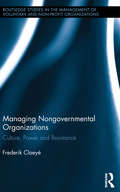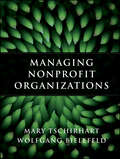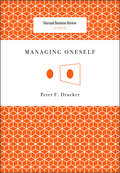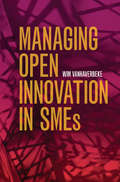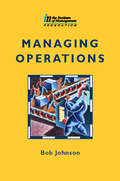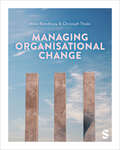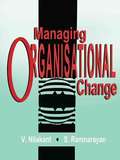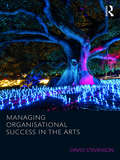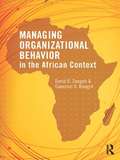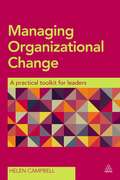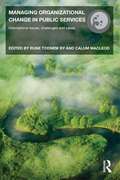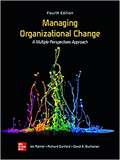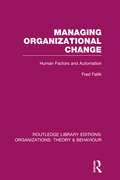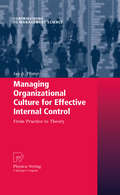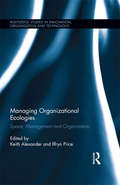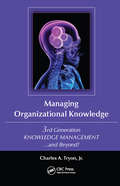- Table View
- List View
Managing Noise and Vibration at Work: Assessment, Measurement And Control
by Tim SouthNew EU Physical Agents Directives on Noise and Vibration will be incorporated into UK law by February 2006. Explicit action levels for vibration will be introduced, while the action levels for noise will be drastically cut. In order to comply with these Directives, companies need to assess noise and vibration levels and provide necessary protection for their employees. They are also required to monitor and if necessary reduce noise and vibration risks.Managing Noise and Vibration at Work introduces noise and both hand-arm and whole-body vibration by explaining what they are and how they can affect the body, drawing out the similarities and differences between the hazards. It provides clear explanations of the requirements of the EU Directives and explains how to fulfill them. Practical information on measurement, making noise and vibration assessments, and approaches to controlling risk help the reader to understand the issues of noise and vibration exposure in the workplace. The text is supported by information and diagrams of measuring equipment, advice on how to plan a survey, worked examples of necessary calculations, and charts and diagrams that can be used in place of the calculations. Suitable hearing and vibration protection is detailed. Case studies help to set the subject in context and highlight common errors and pitfalls.The book fully covers the syllabuses of the Institute of Acoustics’ certificate courses in Workplace Noise Assessment and Management of Occupational Exposure to Hand-arm Vibration. It will also be of use to those studying for the Diploma in Acoustics and Noise Control. For those studying for the NEBOSH Diploma in Health and Safety, this book satisfies modules 1E and 2E. As the Institute of Acoustics syllabuses are based on the Health and Safety Executive's guidelines, the book will also be a useful up-to-date reference for: risk managers; Health and Safety advisors and managers; occupational hygienists; environmental health officers; and HSE inspectors, especially in the Construction, Manufacturing, Agriculture and Forestry sectors.Tim South is a Senior Lecturer in Acoustics at the School of Health and Human Sciences at Leeds Metropolitan University, and a member of the Institute of Acoustics’ Education Committee. He teaches the Institute of Acoustics courses for the Certificate of Competence in Workplace Noise Assessment, the Certificate in the Management of Occupational Exposure to Hand-arm Vibration, and also the Institute’s Diploma in Acoustics and Noise Control. He has extensive consultancy experience in workplace noise assessments, hand-arm vibration and whole-body vibration exposure assessments.
Managing Nongovernmental Organizations: Culture, Power and Resistance (Routledge Studies in the Management of Voluntary and Non-Profit Organizations)
by Frederik ClaeyéThe idea that international development aid needs to be better managed and coordinated gained currency in the early 1990s. The increasing emphasis on management has resulted in the present vogue of ‘managing for development results’ as one of the central tenets in the discourse on international aid. But how appropriate are these ideas, tools, and techniques for non-governmental development organizations (NGOs), and how much does geographic context matter? Examining the current debate on aid effectiveness and the role of NGOs in contributing to it, this book highlights the critical importance of understanding how the global and the local interact to increase aid efficacy and develop more culturally astute ways of managing NGOs. With a focus on NGOs active in sub-Saharan Africa as case studies, author Frederik Claeyé demonstrates that NGOs are not mere passive recipients of management knowledge and practices emanating from the global governance structure of international aid, but actively engage with these ideas and practices to translate and rework them through a local cultural lens. This process results in the emergence of unique hybrid management systems that combine the pressure to become more business-like with the mission to satisfy the demands of the communities they serve.
Managing Nonprofit Organizations: Managing Stakeholder Problems In Nonprofit Arts Organizations (Indiana University Center On Philanthropy Series In Governance Ser.)
by Mary Tschirhart Wolfgang BielefeldThis essential resource offers an overall understanding of nonprofits based on both the academic literature and practitioner experience. It shows how to lead, manage, govern, and structure effective and ethical nonprofit organizations. Managing Nonprofit Organizations reveals what it takes to be entrepreneurial and collaborative, formulate successful strategies, assess performance, manage change, acquire resources, be a responsible financial steward, and design and implement solid marketing and communication plans. "Managing Nonprofit Organizations is the only introductory text on this subject that manages to do three critical things equally well: It's comprehensive, covering all the key topics leaders of NPOs need to know about; it's practical, providing lots of examples, case incidents, and experiential exercises that connect the content to the real world; and, best of all (and most unique compared to others), it's research-based, drawing on the latest and best empirical studies that look into what works and doesn't work in the world of nonprofit management. " --Vic Murray, professor, School of Public Administration, University of Victoria "This book is a rarity--a text that can be used both as the focus for academic study and as a source of stimulating ideas for those practitioners who want to explore theories about management and how they can be applied so they can do a better job. Tschirhart and Bielefeld have explained all aspects of nonprofit management and leadership in a way that will stimulate as well as inform. " --Richard Brewster, executive director, National Center on Nonprofit Enterprise, Virginia Tech University "Managing Nonprofit Organizations presents a comprehensive treatment of this important topic. The book satisfies the competencies and curriculum guidelines developed by NASPAA and by NACC and would be ideal for instruction. The book maintains its commitment to informing management and leadership throughout the nonprofit sector. " --Jeffrey L. Brudney, Albert A. Levin Chair of Urban Studies and Public Service, Cleveland State University "This is an important book, written by two of the leading scholars in the nonprofit studies field. Nonprofit managers, board members, funders, educators, and others will find Managing Nonprofit Organizations extremely valuable. " --Michael O'Neill, professor of nonprofit management, University of San Francisco "Here's the book that my students have been asking for--just the right mix of theory presentation, research findings, and practical suggestions to serve the thoughtful nonprofit management practitioner. It will inform, instruct, and ultimately, inspire. " --Rikki Abzug, professor of management, Anisfield School of Business, Ramapo College
Managing Oil Wealth: The Case of Azerbaijan
by Eric Le Borgne Stephan Danninger John Wakeman-Linn Chonira Aturupane Koba Gvenetadze Niko HobdariOil and gas production in Azerbaijan are projected to increase sharply in 2005 and 2006, respectively, reaching peaks of 1. 3 million barrels per day in 2009 and 20 billion cubic meters per year in 2010. Although expected revenues over the next 20 years will be substantial, they are projected to return to 2004 levels by 2024. Managing this temporary windfall in a way that allows for economic diversification and increased living standards is the subject of this book, which provides extensive guidance based largely on lessons drawn from the experiences-mostly negative-of other countries.
Managing Oneself
by Peter F. DruckerWe live in an age of unprecedented opportunity: with ambition, drive, and talent, you can rise to the top of your chosen profession regardless of where you started out. But with opportunity comes responsibility. Companies today aren't managing their knowledge workers' careers. Instead, you must be your own chief executive officer. That means it's up to you to carve out your place in the world and know when to change course. And it's up to you to keep yourself engaged and productive during acareer that may span some 50 years. In Managing Oneself, Peter Drucker explains how to do it. The keys: Cultivate a deep understanding of yourself by identifying your most valuable strengths and most dangerous weaknesses. Articulate how you learn and work with others and what your most deeply held values are. Describe the type of work environment where you can make the greatest contribution. Only when you operate with a combination of your strengths and self-knowledge can you achieve true and lasting excellence. Managing Oneself identifies the probing questions you need to ask to gain the insights essential for taking charge of your career.
Managing Online Reputation: How to Protect Your Company on Social Media (Palgrave Pocket Consultants)
by Charlie PownallManaging Online Reputation is a comprehensive look at online reputation management. Drawing on recent examples of organizations managing their online reputations effectively and ineffectively, it provides a practical and visual tool-kit of processes and techniques to help limit and respond effectively to negative situations on social media.
Managing Open Innovation Technologies
by Pär J. Ågerfalk Mikael Wiberg Jenny S. Eriksson Lundström Mats Edenius Stefan HrastinskiOpen innovation increases the profit of companies and organizations via the input and the adoption of new ideas that are transformed into new processes, products, and services. Yet, how do we ensure that adopters of such innovations focus on relevant problems and use appropriate methods? How should we manage open innovation technologies? How can we exploit distributed knowledge and inventions? And how can we promote them successfully on the market? With valuable lessons to be learned from academic research and industrial experiences of e.g. Intel, Nokia, Philips Healthcare, small municipalities, e-learning platforms and user communities, this book focuses on some of the key dimensions of open innovation and open innovation technologies. It is divided into three themes: theme 1 deals with open innovation as it is in use today, including theoretical underpinnings and lessons from related research fields. Theme 2 analyzes the use of open innovation in organizations today in order to extract best practices. Theme 3 presents forward-looking theoretical research as well as practical future uses of open innovation. Each chapter addresses the particular topics by presenting experiences and results gained in real life projects and/or by empirical research, and clearly states its purpose and how readers are supposed to benefit from it. Overall, the objectives of this book are to advance and disseminate research on systematic open innovation, and to make its results available to practitioners. Thus, the intended target audience includes the international academic community, industrial enterprises, and public authorities.
Managing Open Innovation in SMEs
by Wim VanhaverbekeThe concept of open innovation (OI) has become a very popular topic during the last decade, with an increasing number of small- and medium-sized enterprises (SMEs) embracing OI practices to gain competitive advantage. With the majority of publications focusing on large firms, open innovation in SMEs has received scant attention from both scholars and practitioners. This book seeks to correct this imbalance by providing an in-depth study for both business managers and graduate-level students. Using rich, in-depth case studies from successful companies, it examines different approaches to managing OI in order to develop practical guidelines for implementation. It also highlights important differences between OI strategies in SMEs and large companies. Its findings will be of use to those studying or working in innovation management, open innovation, small business management and entrepreneurship.
Managing Openness
by Mona Haddad Ben ShepherdThe global financial crisis triggered a broad reassessment of economic integration policies in developed and developing countries worldwide. The crisis-induced collapse in trade was the sharpest ever since World War II, affecting all countries and all product categories. A huge shock to the trading system, combined with severe macroeconomic instability, makes it natural for policymakers to call into question the basic underlying assumptions of trade liberalization and openness. In particular, outward-oriented or export-led growth strategies are being reassessed as openness is increasingly associated with greater volatility. However, it is crucial not to lose sight of the dynamic benefits that openness can offer. Examples include technology transfer, increased competitive pressure that reduces markups and improves efficiency, and economies of scale. The real question is how to manage outward-oriented strategies so as to maximize the benefits of openness while minimizing risks. This book aims to contribute to this important and ongoing policy debate, bringing together recent empirical work on the trade collapse, its causes and consequences, and the broader trade policy agenda in the post-crisis environment. It addresses critical policy issues revolving around the topic of outward-oriented growth strategy, including policy instruments that help manage risks associated with outward-orientation, lessons learned from the crisis for particular countries and regions, and how emerging trade policy issues such as climate change, commodities, global production networking, and migration affect the prospects for recovery and outward-oriented growth.
Managing Operations
by Bob Johnson Alan HartManaging Operations is a concise guide to the fundamentals of operations management. Using examples and case studies from public, private and voluntary sector organizations, this book will enable managers to develop their competency to an excellent standard in an industrial or commercial setting. As well as being very practically based, Managing Operations also provides the theory behind operations management.The book is based on the Management Charter Initiative's Occupational Standards for Management NVQs and SVQs at level 4. It is particularly suitable for managers on the Certificate in Management, or Part 1 of the Diploma, especially those accredited by the IM and Edexcel.Managing Operations is part of the highly successful series of textbooks for managers which cover the knowledge and understanding required as part of any competency-based management programme. The books cover the three main levels of management: supervisory/first-line management (NVQ level 3), middle management (Certificate/NVQ level 4) and senior management (Diploma/NVQ level 5). Also included are titles which cover management issues in particular sectors, such as schools or the public sector, in more depth. You will find a full listing of other titles available at the front of this book.Bob Johnson is a freelance management consultant and trainer with extensive experience of the retail, service, government and voluntary sectors. He has managed operations in the sales, marketing, purchasing, training and consultancy functions.
Managing Organisational Change
by Allan Ramdhony Christoph ThieleDiscover a fresh perspective on managing organisational change in this accessible textbook which links theory to practice and brings complex concepts to life. Structured around the three pillars of successful change management, the book examines change in the context of the global economy and looks at a range of international examples. Key features include: Case studies which explore the practical implications of change issues through companies such as the Alibaba Group, NHS England, GSK, Tata Motors, Nike, Hewlett-Packard and Indonesia’s Krakatau Steel. Practical and reflective exercises to encourage experimentation with tools and techniques, and to deepen understanding.
Managing Organisational Change
by Allan Ramdhony Christoph ThieleDiscover a fresh perspective on managing organisational change in this accessible textbook which links theory to practice and brings complex concepts to life. Structured around the three pillars of successful change management, the book examines change in the context of the global economy and looks at a range of international examples. Key features include: Case studies which explore the practical implications of change issues through companies such as the Alibaba Group, NHS England, GSK, Tata Motors, Nike, Hewlett-Packard and Indonesia’s Krakatau Steel. Practical and reflective exercises to encourage experimentation with tools and techniques, and to deepen understanding.
Managing Organisational Change
by S Ramnarayan V NilakantDrawing upon and integrating current theories, models, and experiences of companies in India and abroad, this book offers practical insights into managing change. It emphasises both what organisations need to change and how they should go about it. Examining primary data from about 50 progressive Indian organisations, the authors view organisational change in terms of three generic--growth; transformation and decline. Based on the case studies, they present a model of change that focuses on eight levers of change--value-based leadership, strategy, structure, human resource practices, technology, marketing, quality and costs. The model is richly illustrated with examples from both Indian and international practice. The authors examine the core values that must underlie any change effort and discuss the ways in which organisations can nurture value-based change. This timely and lucid book will be an indispensable reference or text for all behavioural and management programs.
Managing Organisational Success in the Arts (Routledge Research in Creative and Cultural Industries Management)
by David StevensonThe creative and cultural industries are a dynamic and rapidly expanding field of enterprise. Yet all too often the dominant narrative about arts organisations is one of crisis, collapse, and closure. This edited collection seeks to challenge that narrative through pursuing a focus on organisational success in the management of creative and cultural organisations. This book offers a robust and in-depth analysis of nine international case studies exploring how different organisations have achieved their objectives through effectively managing their resources. Spanning a broad cross section of the cultural sector including Theatres; Multi-Arts Venues; Performing Arts Companies; Museums and Galleries; and Festivals and Events, these cases highlight the importance of examining an individual organisation’s success in relation to its environmental context, revealing not only how arts organisations work in practice, but also providing inspiration and encouragement for those wishing to emulate such success. With an explicit focus on examining theory in practice, this unique collection will be of great interest to students, academics, and practitioners alike. While traditional approaches have often been overly theoretical, this pragmatic approach will help students to gain a richer understanding of how to manage cultural and creative organisations more effectively.
Managing Organizational Behavior in the African Context
by Constant D. Beugré David B. ZoogahManaging Organizational Behavior in an African Context discusses management and organization science theories as they apply within the social, cultural and economic contexts in which organizations operate in Africa. The first organizational behavior book to cover the entire continent, it uses the findings of OB studies to establish a conceptual foundation, then explores how those topics apply in Africa's unique business environment. This integrative framework allows students and scholars to connect organizational phenomena in Africa with those in other parts of the globe. Illustrative examples, mini-cases, and self-assessment exercises all based on Africa-specific sectors, industries, and organizations round out this foundational guide to the OB field in Africa.
Managing Organizational Change
by Helen CampbellA critical area of competitive advantage is the ability of organizations to lead rather than follow changes in the market. This means having the ability to roll out the right changes quickly and reliably in a way that delivers a return on investment. Managing Organizational Change brings together all the different roles and functions within an organization that a leader has to manage effectively to ensure successful and sustainable organizational change. Centred around the Cycle of Change Model, it provides a practical yet reflective overview of the four things you have to have (culture, capacity, commitment and capability) and the six things you have to do (direct, drive, deliver, prepare, propagate and profit). It explains which type of resources you need in order to achieve long term change, which tasks, roles and activities need to be in place and crucially, how to lead during a time of great unease. Managing Organizational Change will help you deliver better outcomes, reflect on what your organization needs to do better and ensure change is embedded throughout your organization.
Managing Organizational Change in Public Services: International Issues, Challenges and Cases (Routledge Studies in Organizational Change & Development)
by Rune Todnem By Calum MacleodForming part of the Understanding Organizational Change series, Managing Organizational Change in Public Services focuses on the organizational dimension of change management in public services. Combining aspects of change management theory with ‘real life’ practice in the form of organizational cases from different regions and sectors, this edited collection identifies and analyzes significant issues regarding the development, implementation and evaluation of public service change initiatives. Featuring contributions from leading authors in the field, this text provides an overview of organizational change management with a focus on leadership, management, and strategies for change. Looking at cases from Europe and North America, Managing Organizational Change in Public Services offers both a global, as well as a cross-sector analysis of this complex and challenging process. Different sectors that are examined include: Transport Health Education This book offers an excellent introduction to change management and how it works within the public service organizations internationally. It will be vital reading for all those engaged with the study or practice of this dynamic subject.
Managing Organizational Change: A Multiple Perspectives Approach
by Ian Palmer David A. Buchanan Richard DunfordThe previous edition of this book was published in 2016. Since then, the organizational world has continued to change dramatically. The aftermath of the global financial crisis is still with us; there are fresh and severe geopolitical tensions; environmental concerns are increasingly urgent; the focus on corporate social responsibility has intensified; organizations are under pressure to demonstrate their environmental, social, and governance (ESG) credentials; technological developments continue to surprise; and cybersecurity is a constant concern. <P><P>Organizations have to consider how to manage demographic trends including an ageing, multigenerational, and multicultural workforce. Consumer preferences and expectations change radically and rapidly. Stir into this mix the impact of social media, where positive and critical views of organizations and their products and services-along with personal and corporate reputations-can be shared instantly and globally. The new content for this edition includes: Real-world examples, Leadership language, Change managers and change leaders, COVID-19 consequences, Technology as a change driver, Initiative overload, Social media, The purpose-driven organization, Counterproductive work behavior, Evidence-based implementation, Change resourcing, Transformational change, Issue-selling, Collective change agency, The politics of change, Chief transformation officer and Pedagogical features.
Managing Organizational Change: Human Factors and Automation (Routledge Library Editions: Organizations)
by Fred FallikThe United States Internal Revenue Service introduced a multi-million dollar program to automate its operations in the early 1980s. This book describes a multidisciplinary study of the experiences of several thousand users in this program, based primarily on questionnaires, observation and interviews. The case study gives valuable guidance to managers and their consultants involved in planning introduction of new office technology, as well as providing more academic insights into aspects of human behaviour under changing working conditions.
Managing Organizational Culture for Effective Internal Control: From Practice to Theory
by Jan A. PfisterIn times of economic and financial crises, the content of this book rings true. Drawing from interviews with executives, senior managers and/or auditors from renowned companies (eBay, Google, Hewlett Packard, Intel, Levi Strauss & Co., Microsoft, Novartis and many others) and theory from fields of sociology and social psychology, this research study provides an understanding of how "tone at the top" imprints on an organization and why that imprint works. More specifically, it discusses how managers' principles and practices can actively shape an open-minded culture that enhances effective internal control.
Managing Organizational Ecologies: Space, Management, and Organizations (Routledge Studies in Innovation, Organizations and Technology)
by Keith Alexander Ilfryn PriceThe term Facilities Management has become global but fraught with confusion as to what the term signifies. For some, notably in the USA, Facilities Management remains a discipline of human ecology. Elsewhere the term has become conflated with an alternative meaning: providing or outsourcing the provision of various services essential to the operation of particular buildings. This volume redresses that imbalance to remind Facilities Management of its roots, presenting evidence of Facilities Management success stories that engage the wider objectives of the organizations they serve, and engaging students, scholars and critical practitioners of general management with an appreciation of the power and influence of physical space and its place in the theory and practice of organizations. This book includes management perspectives from outside the field to ensure that the issues raised are seen in an organizational and management context, informing debate within the Facilities Management fraternity. It draws on human ecology and the perspective of the firm as, itself, an intra-organizational ecology of social constructs. The ecology of a firm is not restricted to the firm’s boundaries. It extends to wider relationships between the firm and its stakeholders including, in an age of outsourced building services, the Facilities Management supply chain. This volume offers arguments and evidence that managing such constructs is a key role for Facilities Management and an important participant in the provision of truly usable spaces.
Managing Organizational Knowledge: 3rd Generation Knowledge Management and Beyond
by Jr., Charles TryonOrganizations of all sizes and types are facing a duel threat and opportunity. At the very moment when global markets are becoming available, these organizations are losing valuable people resources due to "boomer" retirements and downsizing strategies. As the technologies arrive to facilitate knowledge sharing across organizational and people boun
Managing Organizations in the Creative Economy: Organizational Behaviour for the Cultural Sector (Discovering the Creative Industries)
by Paul Saintilan David SchreiberThe creative and cultural industries represent a growing and important sector in the global economy. Thriving in these industries is particularly tough and organizations face unique challenges in the digital age. This textbook provides a vivid initiation into the creative industries workplace. Managing Organizations in the Creative Economy is the first textbook of its kind, introducing organizational behaviour theories and applying them to the creative world. The text is underpinned by the latest research and theoretical insights into creative industries management and organizational behaviour, covering key topics such as structure, culture and the management of change and creativity as well as contemporary issues such as diversity, sustainability, managing stress, wellbeing and self-care, and remote working. The authors bring theory to life through practical examples and cases provided by industry experts, supported by specially created companion videos featuring managerial responses to the cases. This second edition textbook provides readers with an updated applied theoretical understanding of organizational behaviour that will be of particular benefit to those looking to work in the creative and cultural industries. Students on courses such as arts business, arts management and music business, and even students within the broader study of the entertainment and creative industries, will find this to be a vital read.
Managing Organizations in the Creative Economy: Organizational Behaviour for the Cultural Sector (Mastering Management in the Creative and Cultural Industries)
by Paul Saintilan David SchreiberThe creative and cultural industries represent a growing and important sector in the global economy. Thriving in these industries is particularly tough and organizations face unique challenges in the digital age. This textbook provides a vivid initiation into the creative industries workplace. Managing Organizations in the Creative Economy is the first textbook of its kind, introducing organizational behaviour theories and applying them to the creative world. The text is underpinned by the latest research and theoretical insights into creative industries management and organisational behaviour, covering contemporary issues such as business decision-making, ethics, and sexuality. The authors bring theory to life through practical examples and cases provided by industry experts, supported by specially created companion videos featuring managerial responses to the cases. This unique textbook provides readers with an applied theoretical understanding of organizational behaviour that will be of particular benefit to those looking to work in the creative and cultural industries. Students on courses such as arts business, arts management, music business and even the broader study of the entertainment industries will find this to be a vital read.

